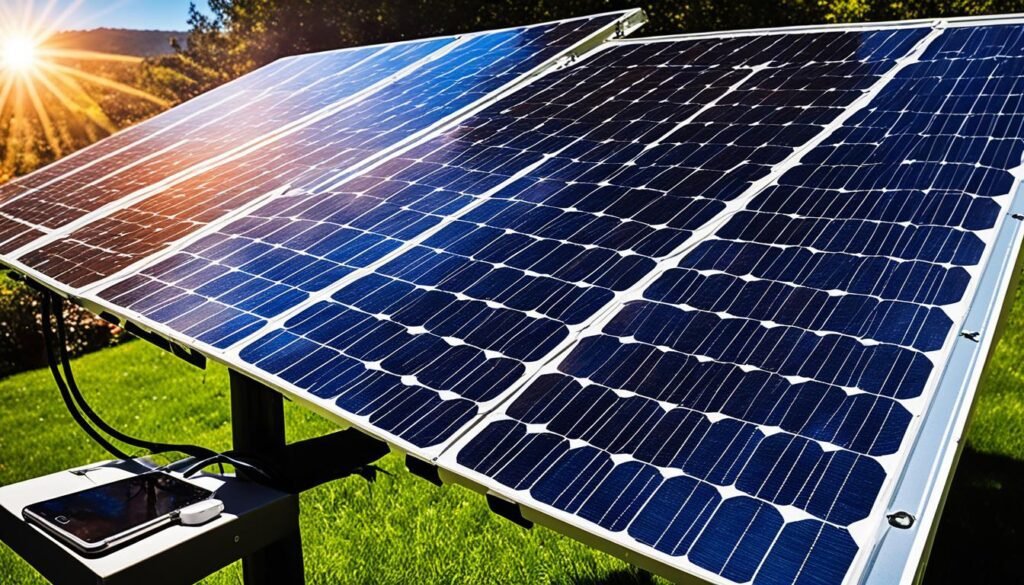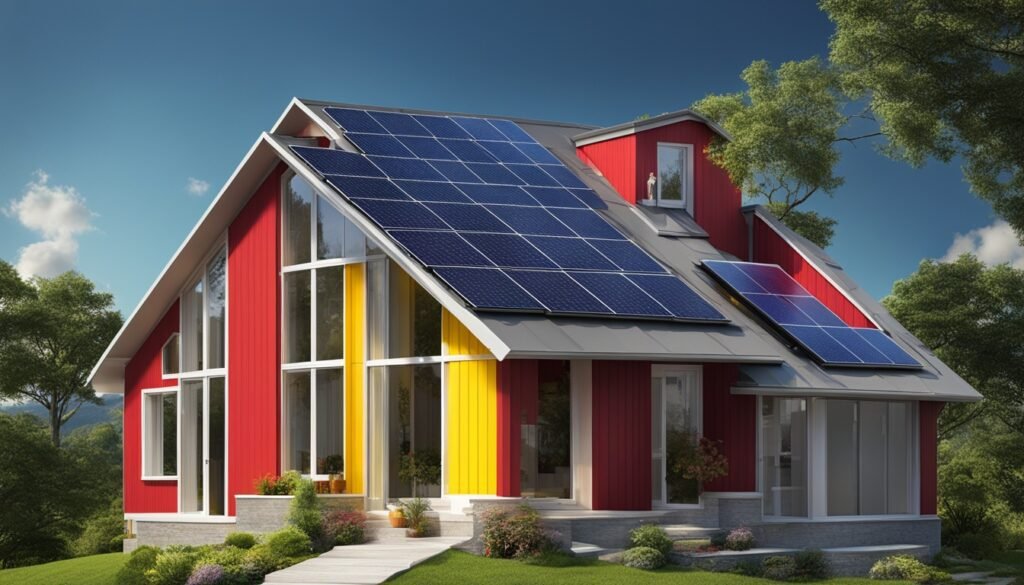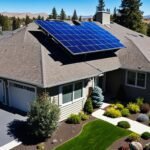Ever thought how a 400 watt solar panel changes our view on sustainable living? These panels are key in using solar power for a greener future. With energy needs growing, they offer a renewable solution. They’re perfect for homes or going off-grid, blending efficiency with power.
Solar technology plays a big role in eco-friendly living. A 400 watt panel is efficient for different energy needs. It’s a key part of living green today. Let’s explore how these panels change the way we use energy at home and beyond.
Key Takeaways
- A single 400 watt solar panel can significantly contribute to sustainable living.
- These panels are efficient and suitable for both residential and off-grid applications.
- Understanding their role is essential in the shift towards renewable energy.
- 400 watt solar panels harness solar power effectively, providing reliable energy solutions.
- They are pivotal in the modern movement toward sustainable energy solutions.
What Is a 400 Watt Solar Panel?
A 400 watt solar panel shows major progress in renewable energy. They stand out for their top efficiency, using the latest materials and electronics for best energy conversion. We’ll look closely at why a 400 watt solar panel is great for homes and remote spots.
Introduction to Solar Panels
A solar panel turns sunlight into electricity. This is done with advanced solar cells that boost the panel’s ability to soak up sunlight and turn it into power. A 400 watt solar panel offers high power, outperforming panels of lower watts.
Key Features of 400 Watt Solar Panels
A 400 watt solar panel is unique for several reasons. They use top-quality silicon cells, increasing efficiency. Higher power output comes from well-placed cells for more sunlight capture and conversion. They also have anti-reflective coatings and special texturing for better sunlight absorption.
Benefits of High-Efficiency Panels
Opting for efficient panels like 400 watt models has many pluses. They save space, fitting more energy production into smaller areas. This means you get more power from the same sunlight, improving your investment. Plus, these panels last longer, making them a smart choice for eco-friendly energy.
| Features | 400 Watt Solar Panels | Lower Wattage Panels |
|---|---|---|
| Power Output | 400 watts | 200-300 watts |
| Efficiency | High | Moderate |
| Space Efficiency | High | Low |
| Durability | High | Moderate |
| Energy Conversion | Advanced | Basic |
Dimensions of 400 Watt Solar Panel
The size of 400 watt solar panels can vary between brands. Yet, there’s a common range that helps us know their usual sizes. This also covers details about portable and foldable models. Plus, it explains installation needs. Understanding these sizes is key for setting up solar energy systems at home or on the go.
Standard Sizes and Variations
We need to know the typical sizes of 400 watt solar panels for our energy projects. They are usually about 79 inches by 39 inches and weigh around 50 pounds. These sizes can change a little depending on the brand and the design. This happens because makers might aim for different uses.
| Brand | Dimensions (Inches) | Weight (Pounds) |
|---|---|---|
| LG | 78.5 x 39.4 | 48.5 |
| SunPower | 79 x 38 | 49 |
| Canadian Solar | 79.5 x 39.1 | 50 |
Portable and Foldable Options
For those wanting flexibility, portable solar panels are a great pick. They can be folded, making them easy to move and store. Brands like VTOMAN and Jackery offer these foldable panels. They’re made to be handy yet powerful. The size of these foldable panels can change. They are small when packed up and bigger when set up.
Installation Considerations
Installing 400 watt solar panels right is very important. This makes sure they work as well as possible. You have to put them up so they get a lot of sun and connect properly. You needs the right mounting gear for the panel size. And, you have to pick the best angle and spot where there’s little shade. Also, check local rules and electrical laws when installing.
How Efficient Is a 400 Watt Solar Panel?
Knowing how efficient a 400 watt solar panel is helps in making smart energy choices. These panels have an efficiency rate of 18% to 23%. This means they produce a lot of power in a small area. This makes them great for both homes and businesses.
The efficiency of a 400 watt solar panel depends on sunlight amount and the temperature. For the best performance, they need ideal sunlight conditions. However, real-life factors like the panel’s angle, surrounding shadows, and sunlight quality affect how well the panel works.
Look at the table below. It shows how different amounts of sunlight change what a 400 watt panel can do:
| Sunlight Intensity | Power Output |
|---|---|
| Full Sunlight (1000 W/m²) | 400 Watts |
| Partial Sunlight (700 W/m²) | 280 Watts |
| Low Sunlight (500 W/m²) | 200 Watts |
To understand 400 watt solar panel efficiency well, we must consider these real conditions. To get the most energy efficiency, it’s important to pick good panels. And, we should try to use them in the best sunlight possible.
What Can You Run With a 400 Watt Solar Panel?
Knowing the power capabilities of a 400 watt solar panel is key for those looking into using them at home or off the grid. They help us power many residential appliances and devices. This makes them great for living sustainably.

A 400 watt solar panel can make about 1.6 to 2.4 kWh of power each day when the sun shines bright. This amount of power can meet many needs that aren’t too demanding. Here’s what you can typically run on a single 400 watt solar panel:
- Charging multiple smartphones or tablets
- Running LED lights for several hours
- Powering a laptop or desktop computer
- Operating small kitchen appliances like a microwave or toaster oven for short periods
- Running energy-efficient refrigerators or freezers
- Powering TV and entertainment systems
For anyone living off-grid, a 400W panel is very helpful. It can power important residential appliances and provide consistent electricity. This is why these panels are chosen for remote cabins, RVs, and tiny homes.
“With multiple 400 watt solar panels connected, the energy needs of even larger households can be efficiently met, demonstrating the robustness of these panels in producing consistent kWh output.”
Now, let’s look at the kWh production compared to common household items:
| Appliance | Power Consumption (Watts) | Running Time with 400W Panel (Hours) |
|---|---|---|
| Laptop | 50W | 32-48 hours |
| LED Light Bulb (10W) | 10W | 160-240 hours |
| Mini Fridge | 100W | 16-24 hours |
| Microwave | 1000W | 1.6-2.4 hours |
Using these panels for off-grid energy lets us keep a modern lifestyle while cutting down on traditional power use. Whether for camping, living off the grid, or making our homes more sustainable, there are many possible uses.
400 Watt Solar Panels for Residential Use
Many homeowners are now choosing solar power to run their homes. The 400 watt solar panel is a popular choice. It meets various home needs, offers savings, and is good for our planet.
Powering Home Appliances
400 watt panels are great for home appliances. They power things like fridges, washing machines, lights, and gadgets. With just one 400W panel, you can keep your home’s essential devices running. Add an energy storage system, and your appliances will work even when you use them a lot.
Grid-Tied vs. Off-Grid Systems
It’s important to know the difference between grid-tied and off-grid solar systems. Grid-tied systems connect to the public electricity grid. This lets you use extra grid power when needed and sell back surplus solar energy. It saves money and gives you a steady power supply.
Off-grid systems don’t use the public grid. They need batteries to store power. They offer complete energy independence but cost more upfront. Both systems have benefits, so your choice depends on your energy needs and budget.
Energy Independence and Savings
400 watt solar panels make your home more energy-independent. You generate your own electricity, reducing dependence on traditional power sources. This also protects you from changing utility prices. Over time, solar panels can save you a lot of money on your energy bills.
Investing in solar power also lowers your carbon footprint. Using renewable energy helps create a better environment for everyone. In short, 400 watt solar panels offer many advantages, including running household appliances, saving money, and making your home greener. Choosing grid-tied or off-grid systems, these panels help pave the way to a more sustainable future.
How Many 400 Watt Solar Panels Do You Need to Run a House?
To figure out the right number of 400 watt solar panels for your home, you need to think about how much energy you use, where you live, and your solar system’s setup. Let’s dig into how to figure out how much energy your home needs.
Calculating Your Energy Needs
Start by looking at your electricity bills to see your monthly and yearly energy use. On average, a U.S. home uses about 877 kWh every month. This helps you understand your energy needs.
To find out how many 400 watt solar panels you need, you should:
- Figure out your daily energy use by dividing your monthly kWh by 30 days. This gives you an average.
- Divide that number by what a 400W panel can produce in a day, about 1.6 kWh under good conditions.

System Size and Configuration
After calculating your energy needs, you can decide on the solar system’s size and layout. The total size depends on how many panels you have and their wattage. Also, how you set up the solar system affects how well it works.
Here’s an example:
| Parameter | Calculation | Result |
|---|---|---|
| Average Daily Energy Use | Month kWh / 30 | 29.23 kWh/day |
| Daily Output per Panel | 1.6 kWh | 1.6 kWh/day |
| Number of Panels Needed | Daily Energy Use / Daily Output per Panel | ~19 Panels |
By knowing our solar panel system size and setup, we can plan our home’s solar power efficiently. Watching our energy consumption helps make sure our move to solar energy fits our residential energy needs well.
How to Clean and Maintain a 400 Watt Solar Panel
It’s vital to clean your solar panels well to keep them working great. Things like dust, debris, and bird droppings can block the sun. This reduces the power they can make.
Begin with a soft cloth or sponge and some mild soap and water for solar panel care. Don’t use rough materials or strong chemicals. They could harm the panel’s top layer. Here’s a cleaning plan that works well:
- Monthly Rinsing: Just rinse the panels with water to get rid of dust and small bits.
- Quarterly Cleaning: Clean more deeply with soap and water. Remember to be gentle.
- Annual Inspection: Check for cracks or damage to fix problems early.
Keeping an eye on how well your panels are working is also key. Many new systems have apps or devices that tell you if the power they’re making drops a lot.
Now, let’s compare different ways to clean them and how good they are:
| Cleaning Method | Effectiveness | Frequency |
|---|---|---|
| Water Rinse | Moderate | Monthly |
| Soap & Water | High | Quarterly |
| Professional Cleaning | Very High | Annually |
With these solar panel care tips, your 400 watt solar panels can last longer and work better.
Cost of a 400 Watt Solar Panel
Understanding the cost of a 400 watt solar panel helps you invest wisely in green energy. Prices vary based on brand, efficiency, and additional features like frames and inverters.
Price Range and Factors Affecting Cost
The price of a 400 watt solar panel can range from $200 to over $500. Factors like material quality, solar cell technology, and the maker play a part. Panels that use high-efficiency tech are more costly but provide better performance.
Best Value and Warranties
It’s key to look at what value a 400 watt solar panel offers beyond the cost. Opt for panels from makers who give long warranties, about 10 to 25 years. This ensures your solar investment lasts longer. Brands like LG and Panasonic offer great warranties and quality panels.
Comparisons with Other Wattage Panels
Comparing 400 watt panels with others can reveal the best value for you. Higher wattage panels usually mean fewer panels are needed, which can save money. But, it’s important to weigh the costs, the efficiency, and what you need to get the most out of your solar tech.


